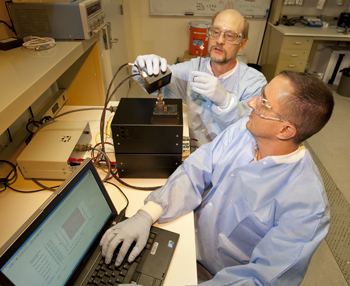Probe-free PCR-based diagnostic assays represent a fascinating advancement in molecular diagnostics, addressing a common observation: the need for streamlined, cost-effective, and highly scalable methods for detecting specific nucleic acid sequences. Their allure stems from their inherent simplicity and versatility, opening up avenues previously inaccessible with traditional probe-dependent methods. They leverage the inherent power of polymerase chain reaction (PCR) while circumventing the constraints imposed by hybridization probes.
Fundamental Principles: Unveiling the Core Mechanism
At their heart, probe-free PCR assays exploit the properties of intercalating dyes or specialized DNA-binding proteins that fluoresce when bound to double-stranded DNA (dsDNA). PCR, a technique involving repeated cycles of DNA denaturation, primer annealing, and enzymatic extension, exponentially amplifies a target sequence. As the amount of dsDNA increases with each cycle, so does the fluorescence signal. By monitoring this fluorescence in real-time, we can quantify the initial amount of the target DNA. Think of it as a molecular flashlight illuminating the burgeoning copies of the target DNA sequence. The brilliance of the light (fluorescence) directly correlates with the initial quantity of what we’re looking for.
The Significance of Probe Independence: Dissecting the Advantages
Why circumvent the use of probes? Traditional probe-based assays, while effective, often require the design and synthesis of specific probes for each target sequence. This adds complexity, increases cost, and limits scalability, particularly when dealing with a large number of targets or rapidly evolving pathogens. Probe-free assays eliminate these limitations. They are inherently more flexible, allowing for the detection of multiple targets in a single reaction (multiplexing) with relative ease. This is because the intercalating dye or DNA-binding protein binds to all dsDNA, regardless of its specific sequence. Furthermore, the reduction in reagent cost and design overhead makes probe-free PCR an attractive option for high-throughput screening and resource-limited settings. Consider the versatility of a universal key unlocking multiple doors instead of needing a uniquely crafted key for each.
Intercalating Dyes: The Workhorses of Probe-Free Detection
Intercalating dyes, such as SYBR Green I, are the most commonly used detection method in probe-free PCR. These dyes bind non-covalently to the minor groove of dsDNA, exhibiting a significant increase in fluorescence upon binding. The intensity of the fluorescence is proportional to the amount of dsDNA present in the reaction. However, this non-specificity also presents a challenge: intercalating dyes bind to all dsDNA, including primer dimers and non-specific amplification products. This can lead to false-positive signals and inaccurate quantification. Therefore, careful primer design and optimization of PCR conditions are crucial to minimize non-specific amplification. Moreover, melt curve analysis, a post-PCR step where the temperature is gradually increased to dissociate the dsDNA, is typically performed to differentiate the specific target amplicon from non-specific products based on their melting temperatures. The sharp, distinct peak corresponding to the target amplicon acts as a fingerprint, distinguishing it from the broader, less defined peaks of non-specific products.
Saturation Dyes and Specialized DNA-Binding Proteins: Refining the Detection Landscape
To overcome the limitations of traditional intercalating dyes, newer saturation dyes and specialized DNA-binding proteins have been developed. Saturation dyes, such as EvaGreen, exhibit reduced PCR inhibition and more uniform binding to dsDNA compared to SYBR Green I, leading to improved accuracy and reproducibility. Specialized DNA-binding proteins, such as those engineered with enhanced specificity, offer another avenue for refining probe-free detection. These proteins bind to dsDNA with greater affinity and specificity than intercalating dyes, reducing the risk of false-positive signals. The advantage here resides in their improved ability to differentiate between the desired target and background noise.
Applications: A Panoramic View of Diagnostic Potential
The applications of probe-free PCR-based diagnostic assays are vast and ever-expanding. They are widely used in microbial diagnostics for the detection and quantification of bacteria, viruses, and fungi. In environmental monitoring, they can be employed to assess water and soil quality by detecting specific pollutants or indicator organisms. Furthermore, they play a crucial role in food safety, enabling the rapid detection of foodborne pathogens and adulterants. Probe-free assays are also finding increasing applications in clinical diagnostics, including cancer detection and genetic screening. Consider the ability to rapidly identify a viral outbreak or to monitor the effectiveness of cancer therapy, all with a single, streamlined assay. The ability to rapidly assess and respond to these challenges positions probe-free PCR as a powerful tool in a variety of fields.
Challenges and Future Directions: Charting the Course Ahead
Despite their numerous advantages, probe-free PCR assays also face certain challenges. The non-specificity of intercalating dyes remains a concern, requiring careful optimization and validation. The development of more specific and sensitive DNA-binding proteins is an ongoing area of research. Another challenge is the potential for primer dimers and other non-specific amplification products to interfere with accurate quantification. Future research efforts are focused on developing novel dyes and proteins with improved specificity, as well as innovative assay designs that minimize non-specific amplification. The integration of microfluidic devices and automation technologies will further enhance the throughput and scalability of probe-free PCR assays, paving the way for their widespread adoption in a variety of diagnostic settings.
In conclusion, probe-free PCR-based diagnostic assays offer a compelling alternative to traditional probe-dependent methods, addressing the demand for simpler, more cost-effective, and highly scalable solutions. Their inherent versatility and adaptability make them a valuable tool in a wide range of applications, from microbial diagnostics to environmental monitoring. As technology continues to advance, probe-free PCR is poised to play an increasingly important role in shaping the future of molecular diagnostics.










Leave a Comment